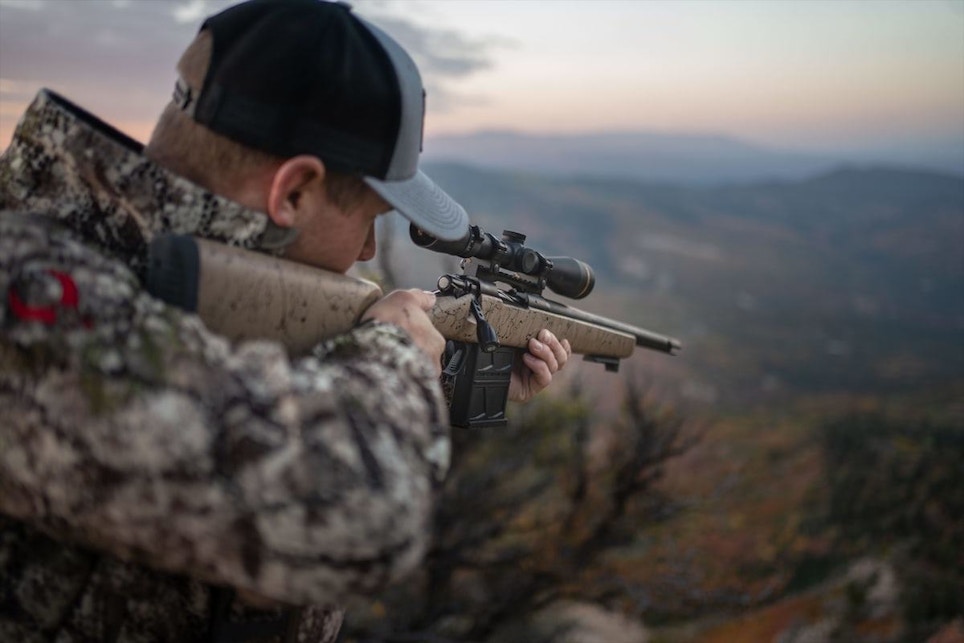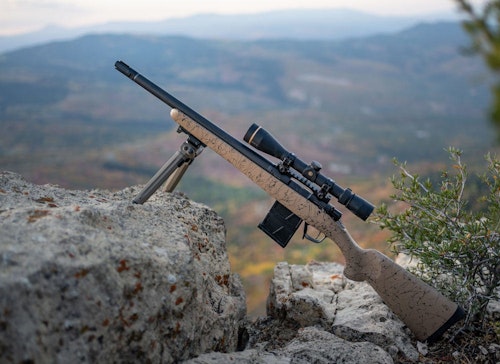Both the concept of the scout rifle and its many actual variations have existed for nearly 40 years. Yet, it’s really only in the last decade that the scout rifle has become a fixture in the firearms marketplace. And Christensen Arms, of Gunnison, Utah, recently added a substantial upgrade to this platform with their new Ridgeline Scout rifle.
In the early 1980s, gun guru and noted firearms trainer Col. Jeff Cooper, founder of the Gunsite Training Facility, introduced the concept of an all-purpose “scout rifle.” As writer Richard Mann noted in his definitive work on the subject, “The Scout Rifle Study: The History of the Scout Rifle and Its Place in the 21st Century,” Cooper had in mind a lighter-weight bolt rifle, one that featured a short action and was outfitted with a barrel no longer than 19-inches. The rifle’s overall length would be under one meter or 39.4 inches.
Cooper wanted a nimble rifle able to get on target quickly, one that could take down nearly any North American game animal excluding the biggest of the bigs (bison, etc.), and given his extensive work in the self-defense field, Cooper included two-footed predators in that listing.
Caliber-wise, Cooper’s preference was a scout rifle chambered in .308 Win., though he recognized that other centerfire calibers could also be employed. The scout would also have ghost ring sights, and a rail forward of the receiver to accommodate a long-eye-relief optic. Ammunition would be fed via a detachable box magazine.
Initially, the scout was only available from a custom gunsmith. Eventually, several of the larger gun manufacturers became making their own take on the scout rifle, including Steyr-Mannlincher of Austria. The Austrian gun maker reportedly worked with Cooper on the Steyr Scout, which was introduced in 1998.
On The Ridgeline
With their Ridgeline Scout, Christensen Arms has built a lightweight, compact rifle that will be at home in the hunting blind, the truck or the open field, and which, in the right hands, can take game out to 400 yards in Cooper’s original .308 Win. chambering.
I received a Ridgeline Scout chambered in .308 Win for evaluation, though it is also available in .223 Rem., 6mm ARC, 6.5 Creedmoor, and 300 Blackout. All Ridgeline Scouts sport 16-inch threaded barrels, weigh just under 6 pounds and measure out at 37.5-inches.
My test Scout featured a Black-Nitride coated action, a 0-MOA optic rail, a forward rail mount/barricade stop located near the front of the fore end, a 10-round AICS drop-box magazine, and a flat-shoe Trigger Tech trigger. A tan and black carbon-fiber composite sporter stock completed the package.
I topped the Scout with a Sightron S-TAC 3-16x42 riflescope, featuring a duplex reticle and 0.25 MOA elevation and windage adjustments, a 30mm tube and target-style turrets plus a side focus adjustment knob. Images seen through the S-TAC were clear and sharp edged, and the elevation and windage adjustments were very precise.
At my outdoor shooting range, I ran the Ridgeline Scout with four different brands of .308 Win. Ammunition. Once it was broken in and I was comfortable with the rifle, all four brands had no problem scoring four- and five-shot groups of 1 inch or less at 100 yards, with me shooting from a sandbagged rest.
My best groups included four shots of Sig Sauer Elite Performance hunting ammunition at just 1 inch, with the shots pegging into two-shot couplets, and Federal Premium’s Gold Medal scoring four shots at just over 1 inch and with the first three shots coming in at under .50-inches.
As with other Christensen Arms rifles I’ve had the pleasure to use and review, the carbon-fiber wrapped Scout barrel cooled off quickly. A good thing for myself especially as I don’t like to wait very long between my accuracy testing shots and groups. The composite stock had a nice grippy feel to it, and it looked very capable of taking on the rough and tumble of hunting afield as well as the life of a truck gun.
The rifle’s barricade stop was a nice touch, too, and at my range allowed me to securely anchor the rifle up against the shooting table for excellent accuracy.
The Ridgeline Scout’s generous bolt handle made for quick and easy loading and unloading. The TriggerTech Flat-Shoe Trigger broke very crisply, with no detectable creep, and the tactical magazine release neatly dropped the 10-round AIC-compatible detachable magazine that came with the rifle.
Multiple Markets
For customers already familiar with Christensen Arms, “We are excited to add the new Ridgeline Scout rifle to the Ridgeline series,” notes Stephen Graham, Christensen’s senior VP of marketing. “The intent was to offer shooters the same familiarity and performance of the Ridgeline in a shorter, more compact system. This Ridgeline Scout has the same accuracy potential and dependability as our field-proven Ridgeline rifles, as they share many of the same features, technology and components.”
Kyle Williams, national account manager for Christensen, added that hunters are a prime market for the Ridgeline Scout.
“The rifle’s 16-inch barrel allows for easy use in an elevated deer stand or a ground blind,” Williams says. “With smaller space to maneuver on a platform or in a deer blind, the shorter overall length of the firearm allows for ease of target acquisition. Caliber offerings are also perfect for in the woods, and for sit-and-wait type of hunting, for anything smaller than elk. And with its threaded barrel, the Scout really begs to be suppressed.”
But don’t ignore the self -defense and tactical market for this rifle.
“For self-defense customers, stress that the Scout is nimble, easy to maneuver, and light weight, and can be used effectively by shooters of all sizes,” Williams notes. “Suppressor-ready, pic rail for a red-dot that could help those familiar with AR-type target acquisition — all of these features speak to the tactically-oriented customer base. And the tactical, oversized bolt knob (standard on the Scout but not other Ridgeline models) allows for easy cycling of rounds and reloading quickly.”
Independent FFLs can buy firearms directly from Christensen. The gunmaker also partners with the following distributors: Bill Hicks, Chattanooga Shooting Supply, Davidson’s, Lipsey’s, MGE Wholesale, RSR Group, Sports South and Zanders.
“We have 16 local sales reps across the country, and they are available for sales staff training and education, and to answer any questions from our dealers,” Williams says.
The Christens Arms YouTube Channel is another great dealer resource, with videos of new products, tutorials and general hunting and shooting tips and ideas.
“Our dealers and their staff may purchase a Christensen Arms firearm, at a discounted price, for their personal use,” Williams says. “And, our dealers and their staff can accumulate points toward the purchase a Christensen Arm, at no cost, through our dealer rewards program.”
Of note, various print and video reviews of the Ridgeline Scout are available for customers and sales staff to review, with more reviews to come.
When a Ridgeline Scout or any other Christensen Arms rifle is sold, FFL sales staff need to know that Christensen recommends a rather extensive barrel break-in process for maximum accuracy. The recommended process includes multiple bore cleanings using bore solvent and two different brushes, plus firing at least 50 rounds of ammunition through the rifle. Inform customers of this issue, and direct them to the Christensen website for the specific how-to details.
Otherwise, some customers will likely do accuracy evaluation of their Ridgeline Scout right out of the box, be disappointed, and have the rifle back in your shop for a refund.
A refund that’s truly not needed for the MOA-or-better Ridgeline Scout rifle.








